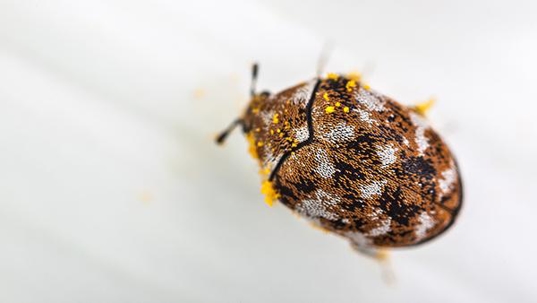Everyone knows pests can destroy property. Of course, there are numerous dangers of termites. Certain kinds of moths can also destroy fabrics like curtains and clothes – as can silverfish. However, not many people are aware that a whole subset of beetles can do significant property damage inside your Houston, TX home.
Carpet beetles eat any animal-based material they can get their antennae on – and they don’t just stop at what people would consider “normal” foods. Carpet beetle larvae can infest anything from organic fabrics like silk and wool to furniture to pelts and even prized insect collections (ironic, we know). In fact, they’re such a threat to the insect and taxidermy collections in museums that they’re often nicknamed the museum bug or museum beetle.
Snug As A Bug In A Rug
There are a few varieties of carpet beetle endemic to our area, but three of the most abundant ones are the varied carpet beetle, the common carpet beetle, and the furniture carpet beetle. All these beetles have slightly different looks and are considered separate species, but they have more in common than not.
All carpet beetles, regardless of species, are typically tiny throughout their lifecycles (usually no more than an eighth of an inch long). As their name suggests, they like to infest carpets – especially carpets made of animal fibers – but they destroy so much more than that.
Like clothes moths and silverfish, carpet beetles can fill your clothing, bedding, and curtains with holes. They can shred your feather pillows, consume your wool or silk upholstered furniture, and even digest leather belts and shoes. Anything containing keratin (a type of animal protein) is fair game to these beetles. If you like to collect mounted insects or taxidermy, these items are also potential food sources for these beetles.
Carpet Beetles: (Not So) Big, Bad Bugs
The problem with carpet beetles is that they’re so tiny and slow that they’re easy to miss. Like bed bugs, carpet beetles aren’t microscopic, but they’re close enough to it that many people look right past them. If your vision isn’t great, it could be totally invisible to you. Their tiny size allows carpet beetles to breed undetected. And it’s their larvae that are the problem.
Adult carpet beetles will lay between 50 and 100 eggs each inside suitable materials. In a few weeks, those eggs hatch and begin to consume whatever food is most convenient – whether it be your favorite silk shirt or your leather armchair.
Beat The Beetles In Your Abode
Many people mistake carpet beetle infestations for moth infestations, and with good reason, as the damage these two pest varieties inflict is often indistinguishable. However, you can distinguish between a moth and beetle infestation by looking at the larvae doing the damage. Larvae from clothes moths look like little, white grub worms, while carpet beetle larvae look almost like fuzzy, segmented roly-polies. Carpet beetle larvae can also be found wandering around the house, whereas moth larvae tend to stay close to their food source.
Avoiding carpet beetle infestation is easier said than done because most carpet beetles fly into your home and lay eggs while you’re none the wiser. It can be tough to keep them out because they’re so small. If avoiding infestation is tough, treating it can be even tougher because you have to clear every potentially infested item individually.
The good news is you don’t have to go it alone. If you wind up with a carpet full of beetles, don’t waste your time with toxic, dangerous mothballs. Contact us here at All-Safe Pest & Termite. Our trained home pest control technicians have the tools and skills to protect your valuables from these destructive pests without exposing you to potentially dangerous toxins.

